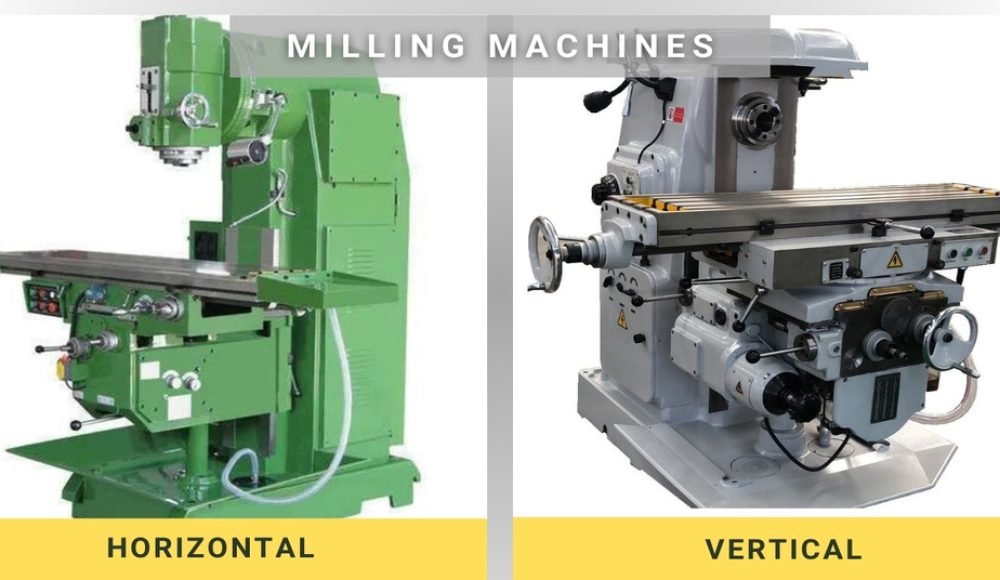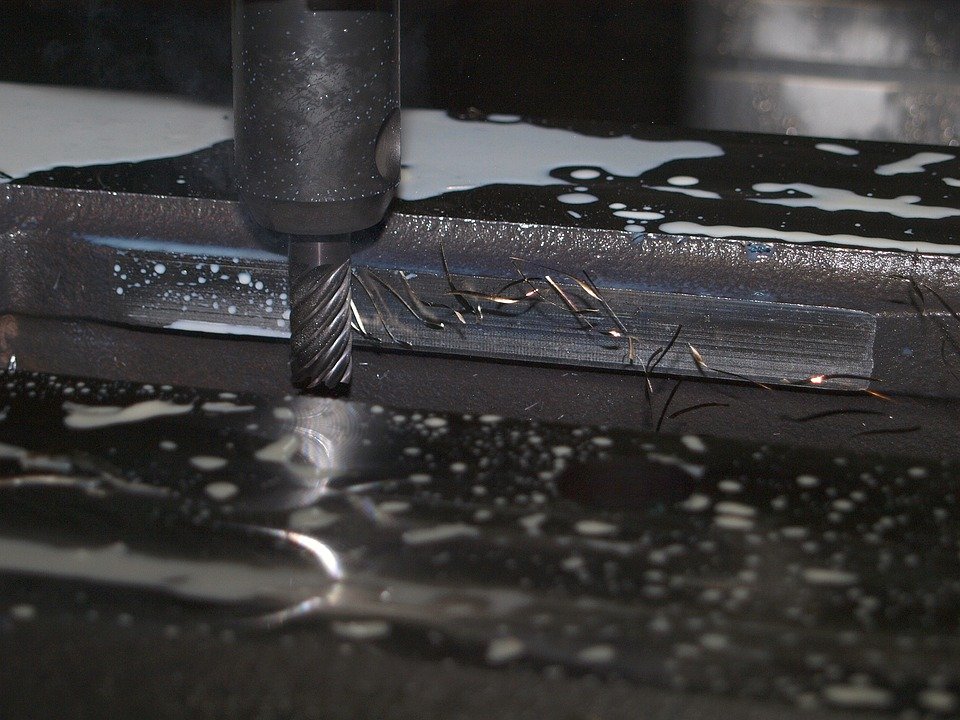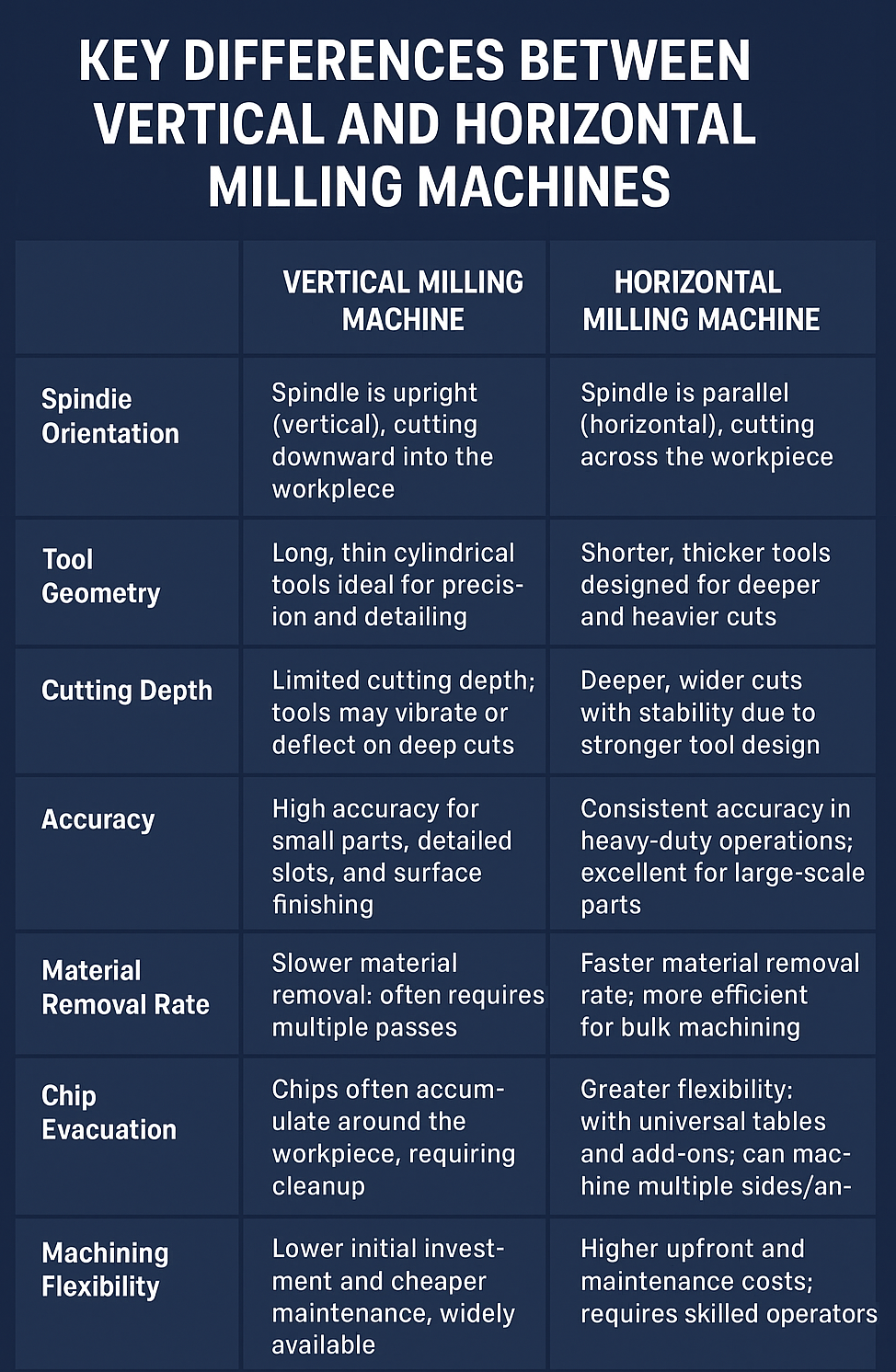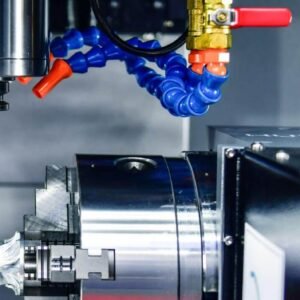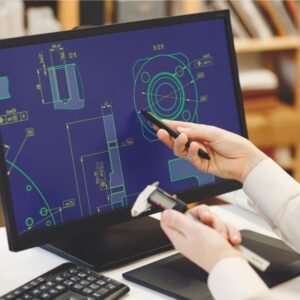The most important distinction in milling machines comes down to the orientation of the spindle—the part that holds and rotates the cutting tool. Based on this factor, machines are generally classified into vertical milling machines そして horizontal milling machines. Each has unique strengths and weaknesses, making them better suited for different applications.
For small workshops and prototyping, vertical machines are the common choice because of their affordability and simplicity. 一方で, large-scale manufacturing operations often favor horizontal machines due to their higher productivity and ability to handle heavier, more complex cuts.
This article takes a close look at both types of machines, briefly explains how they work, and then goes in-depth into their key differences. 最後まで, you’ll have a clear picture of which setup may be right for your machining needs.
A Quick Look at Vertical Milling Machines
Working Principle
A vertical milling machine is designed so that the spindle holding the cutting tool is oriented vertically, ワークに対して垂直. This setup allows the cutting tool to move downward into the material. The workpiece itself remains stationary, securely clamped to the machine table, while the cutting tool gradually carves out material.
Vertical mills are favored for precision work. The vertical spindle allows for better visibility of the cutting area, which means operators can directly monitor the process and make quick adjustments. This makes vertical machines extremely popular in toolrooms, prototyping shops, and small-scale manufacturing.
Another advantage is their versatility for surface-level operations such as slotting, 掘削, 直面している, そして輪郭を描く. しかし, when it comes to deep cuts or working with very large parts, vertical milling machines begin to show their limitations.
Common Types (Turret & Bed Milling)
Vertical milling machines typically come in two main designs: turret mills そして bed mills.
Turret Milling Machines:
Turret mills are compact and designed for smaller parts. The spindle remains fixed in place, but the turret head can swivel and the table can move in multiple directions (X and Y axes). This design makes turret mills excellent for light-duty jobs and parts that need fine detailing. Think of them as the “workhorses” for precision, low-volume machining.
ベッドフライス盤:
Bed mills are larger and more robust. In this design, the spindle can move vertically, while the table moves horizontally along the bed. This setup provides more rigidity and support for heavier parts. Bed mills are more common in traditional machine shops because they strike a balance between precision and the ability to handle medium-sized components.
要約すれば, vertical mills are simpler, easier to learn, and less expensive. They are a natural entry point for many machinists and remain widely used across industries for small-scale or precision machining.
A Quick Look at Horizontal Milling Machines
Working Principle
Horizontal milling machines operate on the same fundamental principle as vertical machines: a rotating cutting tool removes material from a fixed workpiece. しかし, the key distinction is the horizontal orientation of the spindle. This change dramatically alters how the machine performs.
Instead of cutting downward, the horizontally mounted tool cuts across the material. This design makes horizontal machines particularly effective for heavier and deeper cuts, as the tool is shorter and thicker than its vertical counterpart. The stronger tool geometry reduces vibration, allowing the machine to handle more demanding operations with ease.
Horizontal milling machines are commonly used for large-scale production runs, machining of oversized parts, and jobs that require aggressive material removal rates. 航空宇宙のような産業, エネルギー, and heavy equipment manufacturing rely heavily on horizontal setups for their ability to deliver high productivity and robust performance.
Special Capabilities (チップ避難 & Angle Handling)
Two of the biggest advantages of horizontal milling machines are chip evacuation そして angle handling.
チップ避難:
During milling, チップ (small pieces of removed material) build up around the cutting area. In vertical machines, gravity often causes chips to pile up on the workpiece, leading to surface flaws, 過熱, or the need for extra cleanup. Horizontal machines, 一方で, naturally eject chips away from the cutting area thanks to their spindle orientation. This not only improves surface finish but also reduces downtime for cleaning.
Angle Handling:
Horizontal machines are often equipped with a universal table, which allows the workpiece to be rotated and tilted. This capability means the cutter can approach the workpiece from multiple directions, making it easier to machine complex geometries and features. Vertical machines, 対照的に, are restricted to working on a single plane.
本質的に, while horizontal mills require a larger upfront investment, they bring unique advantages that make them indispensable in high-volume, complex machining environments.
Advantages and Disadvantages in Brief
Vertical Milling Machines – Pros & 短所
長所: 手頃な価格, widely available, easier to operate, great for precision work, low maintenance.
短所: Limited cutting depth, slower material removal rate, less effective for large parts.
Horizontal Milling Machines – Pros & 短所
長所: Higher productivity, better chip evacuation, ability to cut at angles, excellent for deep cuts and large parts.
短所: Expensive to buy and maintain, harder to find skilled operators, less suitable for small workshops.
垂直および水平ミルリングマシンの主な違い
Orientation of the Spindle
The most obvious difference between vertical and horizontal milling machines lies in the orientation of the spindle. In vertical milling, the spindle is positioned upright, ワークに対して垂直. This allows the cutting tool to move downward, pressing into the material. The setup makes it easy for operators to visually monitor the process and adjust in real time, which is especially valuable for precision work, プロトタイピング, and smaller projects.
対照的に, horizontal milling machines position the spindle parallel to the workpiece. This horizontal setup means the tool moves across the material instead of down into it. The result is a stronger, more stable cutting process, especially for deeper cuts and larger workpieces. Because the tool is shorter and sturdier, it resists bending or wobbling under heavy loads, something vertical tools often struggle with.
The choice between the two orientations affects not just performance but also the kinds of parts you can produce. Vertical spindles are better for detailed, surface-level machining where accuracy matters most, while horizontal spindles shine in scenarios requiring power, スピード, そして耐久性. 例えば, making molds or precise grooves is best handled by a vertical setup, while cutting a heavy-duty gearbox housing would be more efficient on a horizontal machine.
要するに, the orientation of the spindle sets the stage for how each type of machine functions, directly influencing stability, 切込み深さ, and the complexity of parts you can manufacture.
Tool Geometry and Design
Another key difference comes from the tools themselves. Vertical milling machines use 長さ, slender cylindrical tools, which can reach into tight spaces and handle intricate designs. These tools are perfect for operations like drilling, スロッティング, and contouring where fine detailing is required. しかし, their thin structure makes them more prone to vibration and deflection when tasked with deeper cuts or heavier material removal.
一方で, horizontal milling machines rely on shorter, thicker tools. These cutters are designed to withstand greater resistance without bending or wobbling. The geometry makes them ideal for tackling bulkier workpieces and performing deep or wide cuts in fewer passes. さらに, horizontal mills can accommodate specialized cutters, like side-and-face cutters, slab mills, and gang milling setups, which allow multiple cuts simultaneously.
Tool geometry directly impacts productivity and part quality. 例えば, if you’re machining a small aluminum component that requires precise slots, a vertical machine’s slim tool is perfect. But if you’re working with hardened steel and need to remove a significant amount of material quickly, the robustness of horizontal tools will deliver far better results.
This difference in tool design underscores why each machine has its niche. While vertical mills focus on precision and accessibility, horizontal mills emphasize power and efficiency.
Cutting Specifications and Accuracy
When it comes to accuracy, vertical milling machines usually take the lead, especially for fine, detailed work. Their upright spindle orientation provides excellent visibility, allowing machinists to see exactly what the tool is doing. This hands-on control helps achieve tight tolerances, making vertical machines the go-to choice for prototypes, 金型, and parts that require intricate finishing.
しかし, accuracy doesn’t always equal efficiency. Vertical tools, due to their longer and thinner design, become less stable when deeper cuts are needed. This instability causes vibration, おしゃべり, or even deviations from the intended design. 結果として, vertical mills are limited in how much material they can remove in a single pass.
Horizontal milling machines, 対照的に, may not match the extreme precision of vertical setups in delicate jobs, but they excel at consistency under load. Thanks to their thicker tools and rigid design, they can handle deeper, heavier cuts without sacrificing accuracy. Modern CNC horizontal mills even integrate advanced control systems that allow them to rival vertical machines in precision while still delivering unmatched productivity.
The takeaway? If your project involves thin walls, shallow slots, or aesthetic finishing, a vertical mill is often superior. But if you need deep bores, wide grooves, or heavy-duty machining with consistent tolerances, horizontal machines will outperform every time.
Cost and Maintenance
Cost is often the deciding factor for many workshops when choosing between vertical and horizontal milling machines. Vertical mills are generally much more affordable to purchase, with entry-level models available for small workshops and training centers. Their design is simpler, which means lower maintenance requirements and fewer breakdowns. さらに, because they are so common, finding spare parts or skilled operators is rarely a problem.
Horizontal milling machines, しかし, come with a heftier price tag. Not only are they more expensive to purchase upfront, but they also require higher ongoing costs for maintenance and repair. Their complex construction and heavier workload mean that operators need specialized training, and replacement parts can be harder to source. These factors combine to make horizontal mills a larger investment in both time and money.
That said, the higher cost comes with proportional benefits. Horizontal mills can remove material faster, handle larger jobs, and maintain productivity in high-volume manufacturing environments. For large companies producing thousands of identical parts, the investment often pays for itself in reduced machining time and increased output.
For small workshops and startups, the affordability of vertical machines makes them the practical choice. But for established businesses where throughput and efficiency are critical, the higher cost of horizontal machines is justified.
材料除去率
The rate at which material can be removed is a defining performance metric in milling, and here horizontal machines are the clear winner. Their tool geometry and orientation allow for もっと早く, deeper cuts, meaning more material can be removed in less time. In a production environment, this translates into shorter cycle times, より高い効率, and the ability to complete large orders quickly.
Vertical milling machines, while precise, are slower by comparison. Their tools can only handle smaller cuts at a time, and operators often need to make multiple passes to achieve the desired depth. This not only extends machining time but also reduces overall productivity, especially when working on large or complex parts.
Another factor is chip management. Horizontal machines naturally clear chips away from the workpiece due to gravity and tool orientation, preventing blockages and overheating. Vertical machines, しかし, often struggle with chip buildup, which can slow operations and negatively impact the finish of the part.
要するに, if productivity and speed are top priorities, horizontal milling is unmatched. Vertical machines, though slower, provide better control for fine work, making them better suited for smaller jobs or custom pieces.
Number of Sides and Machining Flexibility
Flexibility in machining often comes down to how many sides of the workpiece can be accessed without re-clamping. Vertical milling machines are mostly limited to operating on a single plane at a time. While attachments can expand their capabilities somewhat, they remain less versatile compared to their horizontal counterparts.
Horizontal milling machines, particularly those equipped with universal tables, offer far greater flexibility. The universal table allows the workpiece to be rotated and repositioned, enabling the cutter to approach from multiple angles. This feature makes it possible to machine complex shapes, 輪郭, and multi-sided parts in fewer setups.
さらに, horizontal mills can be fitted with add-ons like rotary tables, dividing heads, and multiple cutters, further expanding their versatility. For industries that require complex, multi-axis machining, horizontal setups provide a level of adaptability that vertical machines cannot match.
For simple jobs, the single-plane capability of vertical machines is sufficient and cost-effective. But for parts with intricate geometries or multiple surfaces, the flexibility of horizontal machines saves significant time and effort.
Choosing the Right Machine for Your Needs
Selecting between a vertical or horizontal milling machine is not a one-size-fits-all decision. The right choice depends heavily on your workpiece requirements, 生産量, 予算, and available expertise. Let’s break down these considerations:
1. Workpiece Size and Complexity
If your projects mostly involve small to medium-sized parts that require detailed finishing—like slots, 溝, or intricate patterns—a vertical milling machine is usually the smarter choice. Its tool geometry allows for delicate work and its visibility makes it easier for machinists to oversee precision cuts.
しかし, if you’re machining large or bulky workpieces, such as engine components, 構造フレーム, or industrial molds, a horizontal machine is far more efficient. Its sturdy tool design and powerful spindle orientation can handle bigger loads without compromising stability.
2. 生産量
のために 低音量, カスタム, or prototype work, vertical mills are often ideal. They’re easy to set up, プログラム, and operate, which reduces lead time. This flexibility makes them a favorite among small businesses and prototyping shops.
But if your goal is 大量生産, horizontal machines are unbeatable. Their superior material removal rate and ability to machine multiple sides in one setup mean you can churn out more parts in less time. This productivity is critical for large-scale manufacturing.
3. Budget and Costs
Cost is one of the most decisive factors. Vertical milling machines are より手頃な価格の, both in terms of purchase price and ongoing maintenance. Even small workshops can afford to install one, and operators are widely available.
Horizontal machines, 一方で, represent a hefty investment. The initial cost is high, and the maintenance requires more resources. Skilled operators are harder to find, which can add to labor expenses. That said, for companies with high production demands, the cost is justified because the machine quickly pays for itself through efficiency.
4. Operator Skill and Availability
Another overlooked factor is the availability of skilled machinists. Vertical milling machines are more common, meaning more operators are trained to use them. Training is also easier because the process is simpler.
Horizontal milling machines require specialized knowledge. Since fewer workshops use them, finding operators with real-world experience can be a challenge. For small businesses, this can be a deal-breaker, unless they outsource the work to CNC machining services.
5. Business Model Considerations
のために startups and small fabrication shops, a vertical machine makes sense—it’s versatile, 手頃な価格, and reliable for everyday projects. しかし、 established manufacturing companies that focus on efficiency, throughput, and machining complex parts, a horizontal machine is often the better long-term investment.
結論
The debate between vertical and horizontal milling machines comes down to precision versus productivity. Both machines share the same fundamental principle—using a rotating tool to remove material from a fixed workpiece—but their design differences make them suited for very different tasks.
立型フライス盤 excel in precision work, small to medium-sized parts, and custom or prototype projects. They are affordable, easy to maintain, and ideal for businesses with lower production demands.
横型フライス盤 are powerhouses for heavy-duty operations, large workpieces, and high-volume production. Their ability to perform deep cuts, handle multiple sides, and eject chips efficiently makes them invaluable in large-scale manufacturing, albeit at a higher cost.
結局のところ, the decision comes down to your specific needs, production goals, と予算. For small workshops, the vertical milling machine is often the natural starting point. For industrial-scale operations, the horizontal machine’s superior productivity justifies the investment.
And let’s not forget—outsourcing to CNC加工サービス is a practical alternative. Companies that can’t afford the capital investment of horizontal machines can still access top-tier milling capabilities through professional service providers.
Whether you’re a small business owner, a machinist, or a manufacturing executive, understanding these key differences helps ensure you pick the right tool for the job. In machining, just like in life, choosing the right tool often determines the quality of the outcome.

